Edvard Munch
"Life shakes the hand of death at the moment of conception."
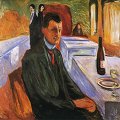 Edvard Munch is a Norwegian Symbolist/Expressionism painter,
acclaimed to be the greatest artist of Norway and a father of
Expressionism. The purpose of Expressionism and Symbolism is to show
emotions that the artist feels in hopes that the viewer will be
stirred and feel them as well. The artist is not concerned with
reality as it appears but with its inner nature and with the emotions
aroused by the subject. To achieve these ends, the subject is
frequently exaggerated, distorted, or otherwise altered in order to
stress the emotional experience in its most intense and concentrated
form.
Edvard Munch is a Norwegian Symbolist/Expressionism painter,
acclaimed to be the greatest artist of Norway and a father of
Expressionism. The purpose of Expressionism and Symbolism is to show
emotions that the artist feels in hopes that the viewer will be
stirred and feel them as well. The artist is not concerned with
reality as it appears but with its inner nature and with the emotions
aroused by the subject. To achieve these ends, the subject is
frequently exaggerated, distorted, or otherwise altered in order to
stress the emotional experience in its most intense and concentrated
form.
- The Sick Child (1886)
- Death in the Sickroom (1895)
- The Scream (1893)
- The Voice (1895)
- The Vampire (1894)
- Madonna (1895)
- Anxiety (1894)
- Puberty (1895)
- Red and White (1894)
- Young Girl on the Shore (1896)
- The Dance of Life (1900)
- The Kiss (1897)
- Self-Portrait with a Wine Bottle (1906)
- Nude by the Wicker Chair (1929)
- Starry Night (1893)
- Self Portrait, Between Clock and Bed (1942)
The Sick Child (1886)
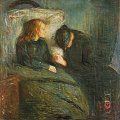 Get
Get  a high-quality picture of
The Sick Child for your computer or notebook. ‣
In this painting, Edvard Munch shows, as the center of attention, a
stricken young girl, propped on a thick white pillow, covered with a
heavy blanket, at the end of her short life. A grieving companion sits
next to her, her head so deeply bowed that we can only see the top of
her head, not her features. The companion is so overcome with grief
that she can neither hold her head up, nor look at the dying girl.
Only the young girl's haunting profile is visible, as she looks
steadily toward a dark ominous drape, perhaps representing the unknown
or the mystery of death. Her reddish hair appears thin, damp, and
uncombed against the pillow.
a high-quality picture of
The Sick Child for your computer or notebook. ‣
In this painting, Edvard Munch shows, as the center of attention, a
stricken young girl, propped on a thick white pillow, covered with a
heavy blanket, at the end of her short life. A grieving companion sits
next to her, her head so deeply bowed that we can only see the top of
her head, not her features. The companion is so overcome with grief
that she can neither hold her head up, nor look at the dying girl.
Only the young girl's haunting profile is visible, as she looks
steadily toward a dark ominous drape, perhaps representing the unknown
or the mystery of death. Her reddish hair appears thin, damp, and
uncombed against the pillow.
The two figures make contact by holding hands for comfort. The artist omits the details of fingers, and just indicates a simple connected shape for both hands. Striving for only simplified and essential forms, Munch enhanced each surface by impassioned brushstrokes, nuanced colors, and thick layers of impasto paint.
Done early in his career (Munch was only twenty-two), this is one of six paintings by Munch on the theme of the sick child; he also examined the same theme in lithograph, drypoint, and etching over the years. Munch continually returned to the subject of his sister Sophie's death.
Death in the Sickroom (1895)
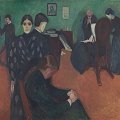 Get
Get  a high-quality picture of
Death in the Sickroom for your computer or notebook. ‣
Death in the Sickroom goes back to the memory of the death of
Munch's beloved sister, Sophie. Otherwise the models are depicted at
the ages they were when the motif was painted, not their ages when the
event took place. Here Munch may have wished to express a dimension of
contemporaneousness - demonstrating that the family would always be
affected by Sophie's death.
a high-quality picture of
Death in the Sickroom for your computer or notebook. ‣
Death in the Sickroom goes back to the memory of the death of
Munch's beloved sister, Sophie. Otherwise the models are depicted at
the ages they were when the motif was painted, not their ages when the
event took place. Here Munch may have wished to express a dimension of
contemporaneousness - demonstrating that the family would always be
affected by Sophie's death.
Munch has many works dealing with the illness (tuberculosis) and death of his dear sister, Sophie. In this painting she is seated in the wicker chair with her back to us. The aura of sanctity is in no way diminished by the medicine bottles, bedpan and paraphernalia of the sickroom. The bed is empty and in the background. The artist directs our focus not to the dying person but to the inner thoughts and grief of the family members, the soon-to-be survivors.
Munch was fourteen when his sister died. Members of the family (who can be identified in so many of his pictures, e.g. "Death Agony," "The Dead Child") are painted not at the ages they were when the event happened, but closer to the ages they were when Munch painted the picture. Munch would not dispute that illness and death laid the foundation for his art. He himself said, "In the same chair as I painted the sick one I and all my dear ones from my mother on have been sitting winter after winter longing for the sun - until death took them away - I and all my dear ones from my father on have paced up and down the floor in anxiety."
Often referred to as the Sigmund Freud of painting, Munch's own psychologic pain is manifested pictorially if not transformed into creative form. The many studies and versions of this painting attest to the importance in his adult years of the memory of his sister's dying, and to the healing power of art in coming to terms with one's personal loss and grief.
The positioning of the relatives captures the paradoxical nature of grief: aloneness and existential isolation even in the midst of a group. Yet, discussing this scene with patients as if it were in a hospital, today, some would point out the simple details of caring (even to the pillow and religious art of choice), the communion without words, the dignity, privacy, and respect - which stand in contrast to some current practices.
The Scream (1893)
 Get
Get  a high-quality picture of
The Scream for your computer or notebook. ‣
The Scream has come more and more to be accepted as Edvard Munch's
most significant motif - the very symbol of modern man, for whom God
is dead and for whom materialism provides no solace. Munch wrote
several versions of a prose-lyrical associated with the motif, one of
which reads: 'I was walking along a path with two friends - the sun
was setting - suddenly the sky turned blood red - I paused, feeling
exhausted, and leaned on the fence - there was blood and tongues of
fire above the blue-black fjord and the city - my friends walked on,
and I stood there trembling with anxiety - and I sensed an infinite
scream passing through nature.'
a high-quality picture of
The Scream for your computer or notebook. ‣
The Scream has come more and more to be accepted as Edvard Munch's
most significant motif - the very symbol of modern man, for whom God
is dead and for whom materialism provides no solace. Munch wrote
several versions of a prose-lyrical associated with the motif, one of
which reads: 'I was walking along a path with two friends - the sun
was setting - suddenly the sky turned blood red - I paused, feeling
exhausted, and leaned on the fence - there was blood and tongues of
fire above the blue-black fjord and the city - my friends walked on,
and I stood there trembling with anxiety - and I sensed an infinite
scream passing through nature.'
The Voice (1895)
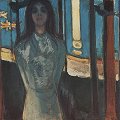 Get
Get  a high-quality picture of
The Voice for your computer or notebook. ‣
There are two painted versions of The Voice, one in the Museum of
Fine Arts in Boston, the other in the Munch Museum. The first version
was exhibited in Berlin in 1893 as the first picture in a series
jointly entitled Study for a Series: Love. These love motifs were the
first works in what would later be known as The Frieze of Life.
a high-quality picture of
The Voice for your computer or notebook. ‣
There are two painted versions of The Voice, one in the Museum of
Fine Arts in Boston, the other in the Munch Museum. The first version
was exhibited in Berlin in 1893 as the first picture in a series
jointly entitled Study for a Series: Love. These love motifs were the
first works in what would later be known as The Frieze of Life.
The Vampire (1894)
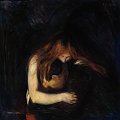 Get
Get  a high-quality picture of
The Vampire for your computer or notebook. ‣
The motif is simple and concentrated in expression. A woman with
long red hair bends over a man, Medusa-like she lets her red hair bind
him to her. The pair cast a single shadow, which groups them in a
classic pyramid composition. Love and Pain, which was the first title
of the motif, indicates an ambition to express complex feelings in
painting.
a high-quality picture of
The Vampire for your computer or notebook. ‣
The motif is simple and concentrated in expression. A woman with
long red hair bends over a man, Medusa-like she lets her red hair bind
him to her. The pair cast a single shadow, which groups them in a
classic pyramid composition. Love and Pain, which was the first title
of the motif, indicates an ambition to express complex feelings in
painting.
Madonna (1895)
 Get
Get  a high-quality picture of
Madonna for your computer or notebook. ‣
The aura-like lines around the model in this main motif from The
Frieze of Life which ripple in a soft and suggestive rhythm, the
half-closed and deep-set eyes allow us to sense the ecstasy of
conception, the pinnacle of love but also an underlying pain. The red
colour of the halo has the associations with both love and blood.
a high-quality picture of
Madonna for your computer or notebook. ‣
The aura-like lines around the model in this main motif from The
Frieze of Life which ripple in a soft and suggestive rhythm, the
half-closed and deep-set eyes allow us to sense the ecstasy of
conception, the pinnacle of love but also an underlying pain. The red
colour of the halo has the associations with both love and blood.
Alluring and inviting, disturbing and threatening, Munch's Madonna is above all mysterious. This erotic nude appears to float in a dreamlike space, with swirling strokes of deep black almost enveloping her. An odd-looking, small fetuslike figure or just-born infant hovers at the lower left with crossed skeletal arms and huge frightened eyes. Little about the Madonna seems to conform to her holy title, save for a narrow dark gold band atop her head. This haunting apparition reflects Munch's alliance with Symbolist artists and writers.
Woman, in varying roles from mother-protector to sexual partner to devouring vampire and harbinger of death, serves as the chief protagonist in a series of paintings and corresponding prints about love, anxiety, and death that Munch grouped together under enigmatic headings. Madonna was first executed as a black-and-white lithograph in 1895. During the next seven years, Munch hand-colored several impressions. Finally, the image was revised in 1902, using additional lithographic stones for color and a woodblock for the textured blue sky.
Anxiety (1894)
 Get
Get  a high-quality picture of
Anxiety for your computer or notebook. ‣
The background landscape, inside Kristiania Fjord, is the same that
we find in The Scream. The pale, ghostly faces come toward us like a
procession of ghosts, in a line which could almost be seen as a
funeral cortege.
a high-quality picture of
Anxiety for your computer or notebook. ‣
The background landscape, inside Kristiania Fjord, is the same that
we find in The Scream. The pale, ghostly faces come toward us like a
procession of ghosts, in a line which could almost be seen as a
funeral cortege.
Puberty (1895)
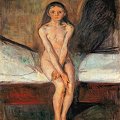 Get
Get  a high-quality picture of
Puberty for your computer or notebook. ‣
Seated centrally on bed and canvas, legs tightly pressed together,
hands clasped between them, covering herself, a naked, adolescent girl
stares directly at the viewer. Her expression is serious, tense,
anxious. Shy and defenseless, her thin lovely, virginal body contrasts
with its dark amorphous shadow cast on the wall behind her.
a high-quality picture of
Puberty for your computer or notebook. ‣
Seated centrally on bed and canvas, legs tightly pressed together,
hands clasped between them, covering herself, a naked, adolescent girl
stares directly at the viewer. Her expression is serious, tense,
anxious. Shy and defenseless, her thin lovely, virginal body contrasts
with its dark amorphous shadow cast on the wall behind her.
The shadow did not appear in Munch's earlier versions of this work nor in the later (1903) etching. Critics hypothesize it is meant to accentuate the trepidation relating to her awakening sexuality, or a menacing sign of death. The shadow's form is rather like a woman's head of long hair which is a motif in many of his works.
Whether a body (e.g., "Vampire'") or decapitated head drained of life-blood, entangled in his mistress's hair (e.g., "Salome"), or a mourning figure more loosely (but still literally) connected to his withdrawing lover by the long strands of her hair (e.g., "Separation" series), the symbol depicts the erotic, destructive power of sexual union with woman.
Red and White (1894)
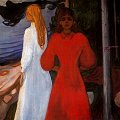 Get
Get  a high-quality picture of
Red and White for your computer or notebook. ‣
In terms of motif, Red and White is related to The Woman/Sphinx,
but instead of the naked and challenging female of that picture, in
Red and White the central woman is dressed in strong red - the colour
of love. The work was also painted over at a later date. To the right
between the trees a dark figure can still be distinguished.
a high-quality picture of
Red and White for your computer or notebook. ‣
In terms of motif, Red and White is related to The Woman/Sphinx,
but instead of the naked and challenging female of that picture, in
Red and White the central woman is dressed in strong red - the colour
of love. The work was also painted over at a later date. To the right
between the trees a dark figure can still be distinguished.
Young Girl on the Shore (1896)
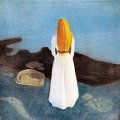 Get
Get  a high-quality picture of
Young Girl on the Shore for your computer or notebook. ‣
The motif is burnished and scraped out with a burnisher, and the
plate is then inked with the finest nuances in blue, yellow and red
using dollies. A total of 11 colour prints of this aquatint are known,
and all differ in some respect. The female figure in white appears in
several of Munch's works, and represents innocence, purity and
beauty.
a high-quality picture of
Young Girl on the Shore for your computer or notebook. ‣
The motif is burnished and scraped out with a burnisher, and the
plate is then inked with the finest nuances in blue, yellow and red
using dollies. A total of 11 colour prints of this aquatint are known,
and all differ in some respect. The female figure in white appears in
several of Munch's works, and represents innocence, purity and
beauty.
The Dance of Life (1900)
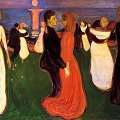 Get
Get  a high-quality picture of
The Dance of Life for your computer or notebook. ‣
The Dance of Life, which Munch pained in 1900, takes place on a
bright summer night along the shore of Aasgaardstrand in Oslo Fjord.
Lit by a full moon, couples engage in an energetic dance. The phallic
reflection of the moonlight in the water gives the scene a mood of
sexuality. In the center of the painting, a man in a dark suit and a
woman in a red dress are sunk within each other. Both of them are in
the prime of their lives. The woman's dress wraps around his legs, a
couple of strains of her hair reach out towards him. His eyes are
closed; the two seem totally self-absorbed and oblivious of others. On
the left side a young girl in a white dress and a smile on her face
enters the scene. Her hand reaches out towards a flower in front of
her. On the opposite side, an old woman stands in a black dress. She
watches the dance of the center couple with a bitter facial
expression, her hands folded in withdrawn.
a high-quality picture of
The Dance of Life for your computer or notebook. ‣
The Dance of Life, which Munch pained in 1900, takes place on a
bright summer night along the shore of Aasgaardstrand in Oslo Fjord.
Lit by a full moon, couples engage in an energetic dance. The phallic
reflection of the moonlight in the water gives the scene a mood of
sexuality. In the center of the painting, a man in a dark suit and a
woman in a red dress are sunk within each other. Both of them are in
the prime of their lives. The woman's dress wraps around his legs, a
couple of strains of her hair reach out towards him. His eyes are
closed; the two seem totally self-absorbed and oblivious of others. On
the left side a young girl in a white dress and a smile on her face
enters the scene. Her hand reaches out towards a flower in front of
her. On the opposite side, an old woman stands in a black dress. She
watches the dance of the center couple with a bitter facial
expression, her hands folded in withdrawn.
Besides the use of color, Munch deepens the differences of the three females by the different use of lines that outline the figures. The adolescent girl on the left is enclosed with sensitive, vibrant strokes. A "swathing, ingestive" line coils around the center female "with her evident appetite for life". In contras, the dark woman on the right, who appears to have withdrawn from the dance of life, is outlined by angular and rigid lines.
The Dance of Life belongs to a series called the Frieze of Life. This frieze was intended as a series of freely adjoining pictures, which would give a clear view of life and the situation of modern man. Munch wrote: "Through them all there winds the curving shore line, and beyond it the sea, while under the trees, life, with all its complexities of grief and joy, carries on". The three major themes of the Frieze of Life, love, anxiety and death are clearly expressed in The Dance of Life. Thus, this painting can be seen as one of the centerpieces in the series.
I am dancing with my true love - a memory of her. A smiling, blond-haired woman enters who wishes to take the flower of love - but it won't allow itself to be taken. And on the other side one can see her dressed in black troubled by the couple dancing - rejected - as I was rejected from her dance.
The possibility of various different interpretations of Munch's painting The Dance of Life is clearly fascinating. Through his revelation of his most personal experiences, Munch strives to create universal symbols and values. Thus, this painting becomes a "parable of human existence and of destiny that dominates our adventure on earth".
The Kiss (1897)
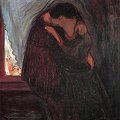 Get
Get  a high-quality picture of
The Kiss for your computer or notebook. ‣
Munch painted a number of variations of the motif Kiss, placing the
couple in various positions but always expressing the tension between
life rushing past outside and the timeless, frozen moment inside. In
this version Munch explores the effect of back lighting, which
contributes to the abstract, surface-like nature of the couple whose
bodies glide across each other into a single shape.
a high-quality picture of
The Kiss for your computer or notebook. ‣
Munch painted a number of variations of the motif Kiss, placing the
couple in various positions but always expressing the tension between
life rushing past outside and the timeless, frozen moment inside. In
this version Munch explores the effect of back lighting, which
contributes to the abstract, surface-like nature of the couple whose
bodies glide across each other into a single shape.
Self-Portrait with a Wine Bottle (1906)
 Get
Get  a high-quality picture of
Self-Portrait with a Wine Bottle for your computer or notebook. ‣
In Self-Portrait with a Bottle of Wine Munch is equally melancholic
and passive, as he appears self-confident in Self-Portrait with
Brushes. The entire position, the relaxed hands and the resigned
expression, indicate that all power has deserted him. The atmosphere
presses down on the artist, conveying an oppressive feeling of
melancholy and loneliness.
a high-quality picture of
Self-Portrait with a Wine Bottle for your computer or notebook. ‣
In Self-Portrait with a Bottle of Wine Munch is equally melancholic
and passive, as he appears self-confident in Self-Portrait with
Brushes. The entire position, the relaxed hands and the resigned
expression, indicate that all power has deserted him. The atmosphere
presses down on the artist, conveying an oppressive feeling of
melancholy and loneliness.
The "Self-Portrait with a Wine Bottle" is not a representation of the physical appearance of the painter, Edvard Munch, but rather it is a psychological expression of his inner dilemmas. As such we can call this a portrayal of the painter's troubled psyche.
Therefore, this picture cannot be explained like a photograph, by the images it conveys. It can only be understood by the clear definition of what it represents. The feelings such as fear, loneliness, hopelessness, uncertainty, and concepts such as phobia, isolation and death are symbolized by the unique technique of the artist and the symbolic values of the few discernable objects in the painting.
The use of colors itself, in the first place, gives the painting a grim tone. Most hues are dull and cold and warm hues have darkness and contrasts in themselves. For example, as stated in the oppressing dark red background puts the man in a state of tortured existence. A striking exception in the usage of colors is the brightly colored necktie, which is a focus of attention in the painting and is a vivid blood red. This may well be a metaphor and the tie most probably represents his jugular. I assume that this is one of the symbols representing death. Another is the tables, which make one think of "white clad coffins".
The artist has an expression of nearly catatonic lament; and lines of pain and anguish is visible in his features, as well as represented by his distorted form. The people in the background seem distant and cold, giving a sense of alienation and helplessness. As such, the only friendly figure in the painting seems to be the wine bottle, which stands out in the picture and is seemingly has more "substance" than anything else, except the painter, in the picture. This can be explained by Munch's increasing subsistance on tobacco and alcohol.
This most certainly defines the psychological state of Munch in 1906, lonely and in anguish. His life has always been an oppressing and painful one, yet his neurosis reached its zenith in those years and after a neural breakdown in 1908-09, he was voluntarily confined in Dr. Jacobson's clinic.
Nude by the Wicker Chair (1929)
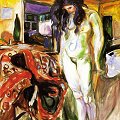 Get
Get  a high-quality picture of
Nude by the Wicker Chair for your computer or notebook. ‣
Here the female model poses naked in front of the wicker chair with
her head bent and arms dangling. The vigorous colouring makes the
picture a rare gem from this period. The room, which opens into new
rooms in the background is a new feature in Munch's composition, which
stands in strong contrast to his many previous closed, bare rooms.
a high-quality picture of
Nude by the Wicker Chair for your computer or notebook. ‣
Here the female model poses naked in front of the wicker chair with
her head bent and arms dangling. The vigorous colouring makes the
picture a rare gem from this period. The room, which opens into new
rooms in the background is a new feature in Munch's composition, which
stands in strong contrast to his many previous closed, bare rooms.
Starry Night (1893)
 Get
Get  a high-quality picture of
Starry Night for your computer or notebook. ‣
In the group of starry night motifs seen from Munch's veranda at
Ekely, where the blue winter night conveys a fateful sense of
melancholy, we see how Munch makes use of rounded shapes in
constructing the painting. The shadow in the foreground - in all
likelihood Munch's own shadow - expresses loneliness in the face of
death.
a high-quality picture of
Starry Night for your computer or notebook. ‣
In the group of starry night motifs seen from Munch's veranda at
Ekely, where the blue winter night conveys a fateful sense of
melancholy, we see how Munch makes use of rounded shapes in
constructing the painting. The shadow in the foreground - in all
likelihood Munch's own shadow - expresses loneliness in the face of
death.
Self Portrait, Between Clock and Bed (1942)
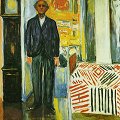 Get
Get  a high-quality picture of
Self Portrait, Between Clock and Bed for your computer or notebook. ‣
With the stance of an old man, Munch places himself between two
symbols of death, the clock and the bed. He stands there alone on the
treshold between the sun-filled room behind him overflowing with works
of art - what has been his life - and the bedroom where the shadow on
the floor in front of him forms the shape of a cross.
a high-quality picture of
Self Portrait, Between Clock and Bed for your computer or notebook. ‣
With the stance of an old man, Munch places himself between two
symbols of death, the clock and the bed. He stands there alone on the
treshold between the sun-filled room behind him overflowing with works
of art - what has been his life - and the bedroom where the shadow on
the floor in front of him forms the shape of a cross.
A figure stands left of center, erect and facing forward in a room. He is, as described by the painting's title, standing between the tall grandfather clock and the bed. Vibrantly colored and painted with a tumultuous energy, this image does not immediately connote Munch's typical themes of death and sickness. Yet his hands hang limply by his side, and the clock (sans hands or numerals) and bed can be understood symbolically, not only as a statement of the relationship between time and sleep, but also as to where Munch sees himself in his artistic career. (He appears to be stepping forward into the room, no longer concerned with time, "impassively awaiting death".
This late self-portrait places Munch in his own colorful world, his pictures and artifacts surrounding him. Other self-portraits painted during this last decade of his life depict the figure even more mannequin, skeletal-like, and obviously aged.
Edvard Munch Art

|
|
More
Articles
 Art Encyclopedia A world history of art in articles.
Art Encyclopedia A world history of art in articles.
Modernism
Edvard Munch
Art, life, and world of symbolic expression.
Art, paintings, and works.
The Scream.
Art
 Art Wallpapers Art image collections for your desktop.
Art Wallpapers Art image collections for your desktop.
Munch Art, $19
(75 pictures)
Malevich Art, $25
(105 pictures)
Modigliani Art, $29
(135 pictures)
Klee Art, $25
(150 pictures)
Miro Art, $35
(150 pictures)
Matisse Art, $29
(180 pictures)
Picasso Art, $29
(175 pictures)
Dali Art, $35
(275 pictures)
Chagall Art, $35
(175 pictures)

